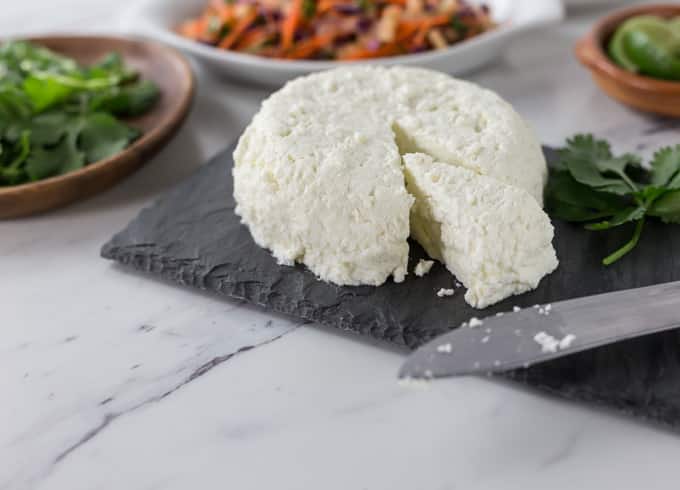
How to Make Perfect Queso Fresco
Want to make queso fresco at home? Here is an easy recipe to make this homemade cheese that is a popular topping for tacos, nachos, enchiladas and tostadas. Many Latin foods use this ingredient and it is so easy.
Print
Pin
Servings: 8 servings
Calories: 148kcal
Ingredients
- ½ gal whole milk
- ⅔ cup vinegar white, distilled
- 1 Tbsp apple cider vinegar
- 1 ½ tsp Kosher salt
Instructions
- Place a cheese cloth lined colander over a large bowl of pasta pot.
- On medium heat bring milk to 170°F, stirring constantly to avoid uneven heating.
- When the milk reaches the desired temperature, remove from heat and add vinegar types. Stir a couple of times, then allow it to sit untouched on the stove top for about 30-45 minutes.
- Using a knife start breaking up the curds gently then start transferring to a colander using a slotted spoon.
- Allow the curds to sit untouched for about 30 minutes so they can drain properly. Add salt and stir lightly.
- Next, gather the edges of the cheesecloth and tie with kitchen twine or a twist tie. Hang from your sink faucet, and allow it to drip for about 30 minutes.
- Remove from the cloth and using your hands gently mold the cheese into a flat disc, about 1" tall.
- Return to the colander and let it sit this way for about 30 minutes.
- Transfer cheese to a bowl, and place in the refrigerator until ready to use.
Notes
Ingredient notes and equipment:
- Whole cow's milk or raw cow's milk: This full fat milk will give the best results. If you have access to goat milk you can try a similar recipe for goat cheese.
- Vinegar: This recipe calls for white distilled vinegar and apple cider vinegar. This is the key ingredient for acid-set cheese or acid coagulated cheeses. Other types of acid-set cheese are cottage cheese, quark or cream cheese.
- Salt: Use cheese salt or a non-iodized salt like Kosher salt.
- Dutch oven or pasta pot: Heat the milk in a large pot and I prefer one with a heavy bottom to give very even heat distribution.
- Digital thermometer: You want to be sure to get the milk to exactly 170°F while stirring.
- Cheesecloth and colander: Line your colander with the cheesecloth to allow the whey to drain off while gather your curds. A slotted spoon work well to scoop them up.
How long can I store queso fresco?
I typically recommend eating the queso fresco within a week, making sure to keep it refrigerated and properly sealed in an airtight container.
Can I rinse the curds before draining?
Yes, you can gently rinse the curds in the cheesecloth and it will remove some of the tangy flavor of the acid used to coagulate the milk. I like a slightly salty and tangy cheese.
How can I make the queso fresco softer or more spreadable?
You can add a small amount of heavy cream to the cheese to get the desired creaminess. You only need a small amount so add a teaspoon at time and mash it into the cheese.
Nutrition
Calories: 148kcal | Carbohydrates: 11g | Protein: 7g | Fat: 7g | Saturated Fat: 4g | Cholesterol: 23mg | Sodium: 538mg | Potassium: 312mg | Sugar: 11g | Vitamin A: 385IU | Calcium: 269mg | Iron: 0.1mg